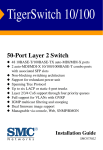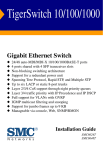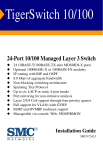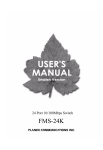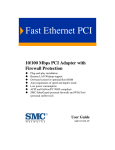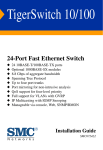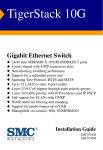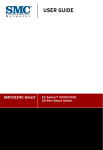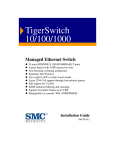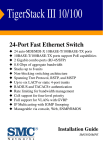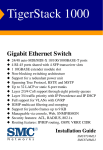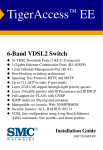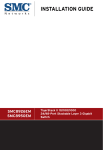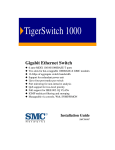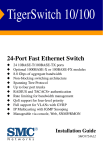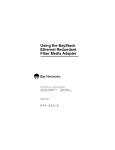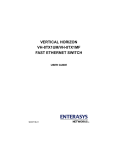Download SMC Networks SMC8624T User's Manual
Transcript
TigerSwitch 10/100/1000 Gigabit EthernetSwitch ◆ ◆ ◆ ◆ ◆ ◆ ◆ ◆ ◆ ◆ ◆ 24 auto-MDI/MDI-X 10/100/1000BASE-T ports 4 ports shared with 4 SFP transceiver slots Non-blocking switching architecture Support for a redundant power unit Spanning Tree Protocol Up to six LACP or static 4-port trunks Layer 2/3/4 CoS support through four priority queues Full support for VLANs with GVRP IGMP multicast filtering and snooping Support for jumbo frames up to 9 KB Manageable via console, Web, SNMP/RMON Installation Guide SMC8624T TigerSwitch 10/100/1000 Installation Guide From SMC’s Tiger line of feature-rich workgroup LAN solutions 38 Tesla Irvine, CA 92618 Phone: (949) 679-8000 June 2002 Pub. # 150200016600A Information furnished by SMC Networks, Inc. (SMC) is believed to be accurate and reliable. However, no responsibility is assumed by SMC for its use, nor for any infringements of patents or other rights of third parties which may result from its use. No license is granted by implication or otherwise under any patent or patent rights of SMC. SMC reserves the right to change specifications at any time without notice. Copyright © 2002 by SMC Networks, Inc. 38 Tesla Irvine, CA 92618 All rights reserved. Printed in Taiwan Trademarks: SMC is a registered trademark; and EZ Switch, TigerStack and TigerSwitch are trademarks of SMC Networks, Inc. Other product and company names are trademarks or registered trademarks of their respective holders. LIMITED WARRANTY Limited Warranty Statement: SMC Networks, Inc. (“SMC”) warrants its products to be free from defects in workmanship and materials, under normal use and service, for the applicable warranty term. All SMC products carry a standard 90-day limited warranty from the date of purchase from SMC or its Authorized Reseller. SMC may, at its own discretion, repair or replace any product not operating as warranted with a similar or functionally equivalent product, during the applicable warranty term. SMC will endeavor to repair or replace any product returned under warranty within 30 days of receipt of the product. The standard limited warranty can be upgraded to a Limited Lifetime* warranty by registering new products within 30 days of purchase from SMC or its Authorized Reseller. Registration can be accomplished via the enclosed product registration card or online via the SMC web site. Failure to register will not affect the standard limited warranty. The Limited Lifetime warranty covers a product during the Life of that Product, which is defined as the period of time during which the product is an “Active” SMC product. A product is considered to be “Active” while it is listed on the current SMC price list. As new technologies emerge, older technologies become obsolete and SMC will, at its discretion, replace an older product in its product line with one that incorporates these newer technologies. At that point, the obsolete product is discontinued and is no longer an “Active” SMC product. A list of discontinued products with their respective dates of discontinuance can be found at: http://www.smc.com/index.cfm?action=customer_service_warranty. All products that are replaced become the property of SMC. Replacement products may be either new or reconditioned. Any replaced or repaired product carries either a 30-day limited warranty or the remainder of the initial warranty, whichever is longer. SMC is not responsible for any custom software or firmware, configuration information, or memory data of Customer contained in, stored on, or integrated with any products returned to SMC pursuant to any warranty. Products returned to SMC should have any customer-installed accessory or add-on components, such as expansion modules, removed prior to returning the product for replacement. SMC is not responsible for these items if they are returned with the product. Customers must contact SMC for a Return Material Authorization number prior to returning any product to SMC. Proof of purchase may be required. Any product returned to SMC without a valid Return Material Authorization (RMA) number clearly marked on the outside of the package will be returned to customer at customer’s expense. For warranty claims within North America, please call our toll-free customer support number at (800) 762-4968. Customers are responsible for all shipping charges from their facility to SMC. SMC is responsible for return shipping charges from SMC to customer. WARRANTIES EXCLUSIVE: IF AN SMC PRODUCT DOES NOT OPERATE AS WARRANTED ABOVE, CUSTOMER’S SOLE REMEDY SHALL BE REPAIR OR REPLACEMENT OF THE PRODUCT IN QUESTION, AT SMC’S OPTION. THE FOREGOING WARRANTIES AND REMEDIES ARE EXCLUSIVE AND ARE IN LIEU OF ALL OTHER WARRANTIES OR CONDITIONS, EXPRESS OR IMPLIED, EITHER IN FACT OR BY OPERATION OF LAW, STATUTORY OR OTHERWISE, INCLUDING WARRANTIES OR CONDITIONS OF MERCHANTABILITY AND FITNESS FOR A PARTICULAR PURPOSE. SMC NEITHER ASSUMES NOR AUTHORIZES ANY OTHER PERSON TO ASSUME FOR IT ANY OTHER i LIMITED WARRANTY LIABILITY IN CONNECTION WITH THE SALE, INSTALLATION, MAINTENANCE OR USE OF ITS PRODUCTS. SMC SHALL NOT BE LIABLE UNDER THIS WARRANTY IF ITS TESTING AND EXAMINATION DISCLOSE THE ALLEGED DEFECT IN THE PRODUCT DOES NOT EXIST OR WAS CAUSED BY CUSTOMER’S OR ANY THIRD PERSON’S MISUSE, NEGLECT, IMPROPER INSTALLATION OR TESTING, UNAUTHORIZED ATTEMPTS TO REPAIR, OR ANY OTHER CAUSE BEYOND THE RANGE OF THE INTENDED USE, OR BY ACCIDENT, FIRE, LIGHTNING, OR OTHER HAZARD. LIMITATION OF LIABILITY: IN NO EVENT, WHETHER BASED IN CONTRACT OR TORT (INCLUDING NEGLIGENCE), SHALL SMC BE LIABLE FOR INCIDENTAL, CONSEQUENTIAL, INDIRECT, SPECIAL, OR PUNITIVE DAMAGES OF ANY KIND, OR FOR LOSS OF REVENUE, LOSS OF BUSINESS, OR OTHER FINANCIAL LOSS ARISING OUT OF OR IN CONNECTION WITH THE SALE, INSTALLATION, MAINTENANCE, USE, PERFORMANCE, FAILURE, OR INTERRUPTION OF ITS PRODUCTS, EVEN IF SMC OR ITS AUTHORIZED RESELLER HAS BEEN ADVISED OF THE POSSIBILITY OF SUCH DAMAGES. SOME STATES DO NOT ALLOW THE EXCLUSION OF IMPLIED WARRANTIES OR THE LIMITATION OF INCIDENTAL OR CONSEQUENTIAL DAMAGES FOR CONSUMER PRODUCTS, SO THE ABOVE LIMITATIONS AND EXCLUSIONS MAY NOT APPLY TO YOU. THIS WARRANTY GIVES YOU SPECIFIC LEGAL RIGHTS, WHICH MAY VARY FROM STATE TO STATE. NOTHING IN THIS WARRANTY SHALL BE TAKEN TO AFFECT YOUR STATUTORY RIGHTS. * SMC will provide warranty service for one year following discontinuance from the active SMC price list. Under the limited lifetime warranty, internal and external power supplies, fans, and cables are covered by a standard one-year warranty from date of purchase. SMC Networks, Inc. 38 Tesla Irvine, CA 92618 ii COMPLIANCES FCC - Class A This equipment generates, uses, and can radiate radio frequency energy and, if not installed and used in accordance with the instruction manual, may cause interference to radio communications. It has been tested and found to comply with the limits for a Class A computing device pursuant to Subpart B of Part 15 of FCC Rules, which are designed to provide reasonable protection against such interference when operated in a commercial environment. Operation of this equipment in a residential area is likely to cause interference, in which case the user, at his own expense, will be required to take whatever measures may be required to correct the interference. You are cautioned that changes or modifications not expressly approved by the party responsible for compliance could void your authority to operate the equipment. You may use unshielded twisted-pair (UTP) cable for RJ-45 connections—Category 3 or greater for 10 Mbps connections, Category 5 for 100 Mbps connections and Category 5 or 5e for 1000 Mbps connections. Use 50/125 or 62.5/125 micron multimode fiber optic cable, or 9/125 micron single-mode cable, for SFP transceiver connections. Warnings: 1. Wear an anti-static wrist strap or take other suitable measures to prevent electrostatic discharge when handling this equipment. 2. When connecting this switch to a power outlet, connect the field ground lead on the tri-pole power plug to a valid earth ground line to prevent electrical hazards. EC Conformance Declaration - Class A SMC contact for these products in Europe is: SMC Networks Europe, Edificio Conata II, Calle Fructuós Gelabert 6-8, 2o, 4a, 08970 - Sant Joan Despí, Barcelona, Spain. This information technology equipment complies with the requirements of the Council Directive 89/336/EEC on the Approximation of the laws of the Member States relating to Electromagnetic Compatibility and 73/23/EEC for electrical equipment used within certain iii COMPLIANCES voltage limits and the Amendment Directive 93/68/EEC. For the evaluation of the compliance with these Directives, the following standards were applied: RFI Emission: • Limit class A according to EN 55022:1998 • Limit class A for harmonic current emission according to EN 61000-3-2/1995 • Limitation of voltage fluctuation and flicker in low-voltage supply system according to EN 61000-3-3/1995 Immunity: • Product family standard according to EN 55024:1998 • Electrostatic Discharge according to EN 61000-4-2:1995 (Contact Discharge: ±4 kV, Air Discharge: ±8 kV) • Radio-frequency electromagnetic field according to EN 61000-4-3:1996 (80 - 1000 MHz with 1 kHz AM 80% Modulation: 3 V/m) • Electrical fast transient/burst according to EN 61000-4-4:1995 (AC/ DC power supply: ±1 kV, Data/Signal lines: ±0.5 kV) • Surge immunity test according to EN 61000-4-5:1995 (AC/DC Line to Line: ±1 kV, AC/DC Line to Earth: ±2 kV) • Immunity to conducted disturbances, Induced by radio-frequency fields: EN 61000-4-6:1996 (0.15 - 80 MHz with 1 kHz AM 80% Modulation: 3 V/m) • Power frequency magnetic field immunity test according to EN 61000-4-8:1993 (1 A/m at frequency 50 Hz) • Voltage dips, short interruptions and voltage variations immunity test according to EN 61000-4-11:1994 (>95% Reduction @10 ms, 30% Reduction @500 ms, >95% Reduction @5000 ms) LVD: • EN 60950 (A1/1992; A2/1993; A3/1993; A4/1995; A11/1997) Warning: Do not plug a phone jack connector in the RJ-45 port. This may damage this device. Les raccordeurs ne sont pas utilisé pour le systéme téléphonique! iv COMPLIANCES Industry Canada - Class A This digital apparatus does not exceed the Class A limits for radio noise emissions from digital apparatus as set out in the interference-causing equipment standard entitled “Digital Apparatus,” ICES-003 of the Department of Communications. Cet appareil numérique respecte les limites de bruits radioélectriques applicables aux appareils numériques de Classe A prescrites dans la norme sur le matériel brouilleur: “Appareils Numériques,” NMB-003 édictée par le ministère des Communications. Japan VCCI Class A Taiwan BSMI Class A Australia AS/NZS 3548 (1995) - Class A SMC contact for products in Australia is: SMC Communications Pty. Ltd. Suite 18, 12 Tryon Road, Lindfield NSW2070, Phone: 61-2-94160437 Fax: 61-2-94160474 v COMPLIANCES Safety Compliance Warning: Fiber Optic Port Safety CLASS I LASER DEVICE When using a fiber optic port, never look at the transmit laser while it is powered on. Also, never look directly at the fiber TX port and fiber cable ends when they are powered on. Avertissment: Ports pour fibres optiques - sécurité sur le plan optique DISPOSITIF LASER DE CLASSE I Ne regardez jamais le laser tant qu’il est sous tension. Ne regardez jamais directement le port TX (Transmission) à fibres optiques et les embouts de câbles à fibres optiques tant qu’ils sont sous tension. Warnhinweis: Faseroptikanschlüsse - Optische Sicherheit LASERGERÄT DER KLASSE I Niemals ein Übertragungslaser betrachten, während dieses eingeschaltet ist. Niemals direkt auf den Faser-TX-Anschluß und auf die Faserkabelenden schauen, während diese eingeschaltet sind. Underwriters Laboratories Compliance Statement Important! Before making connections, make sure you have the correct cord set. Check it (read the label on the cable) against the following: Operating Voltage Cord Set Specifications 120 Volts UL Listed/CSA Certified Cord Set Minimum 18 AWG Type SVT or SJT three conductor cord Maximum length of 15 feet Parallel blade, grounding type attachment plug rated 15 A, 125 V 240 Volts (Europe only) Cord Set with H05VV-F cord having three conductors with minimum diameter of 0.75 mm2 IEC-320 receptacle Male plug rated 10 A, 250 V The unit automatically matches the connected input voltage. Therefore, no additional adjustments are necessary when connecting it to any input voltage within the range marked on the rear panel. vi COMPLIANCES Wichtige Sicherheitshinweise (Germany) 1. Bitte lesen Sie diese Hinweise sorgfältig durch. 2. Heben Sie diese Anleitung für den späteren Gebrauch auf. 3. Vor jedem Reinigen ist das Gerät vom Stromnetz zu trennen. Verwenden Sie keine Flüssigoder Aerosolreiniger. Am besten eignet sich ein angefeuchtetes Tuch zur Reinigung. 4. Die Netzanschlu ßsteckdose soll nahe dem Gerät angebracht und leicht zugänglich sein. 5. Das Gerät ist vor Feuchtigkeit zu schützen. 6. Bei der Aufstellung des Gerätes ist auf sicheren Stand zu achten. Ein Kippen oder Fallen könnte Beschädigungen hervorrufen. 7. Die Belüftungsöffnungen dienen der Luftzirkulation, die das Gerät vor Überhitzung schützt. Sorgen Sie dafür, daß diese Öffnungen nicht abgedeckt werden. 8. Beachten Sie beim Anschluß an das Stromnetz die Anschlußwerte. 9. Verlegen Sie die Netzanschlußleitung so, daß niemand darüber fallen kann. Es sollte auch nichts auf der Leitung abgestellt werden. 10. Alle Hinweise und Warnungen, die sich am Gerät befinden, sind zu beachten. 11. Wird das Gerät über einen längeren Zeitraum nicht benutzt, sollten Sie es vom Stromnetz trennen. Somit wird im Falle einer Überspannung eine Beschädigung vermieden. 12. Durch die Lüftungsöffnungen dürfen niemals Gegenstände oder Flüssigkeiten in das Gerät gelangen. Dies könnte einen Brand bzw. elektrischen Schlag auslösen. 13. Öffnen sie niemals das Gerät. Das Gerät darf aus Gründen der elektrischen Sicherheit nur von authorisiertem Servicepersonal geöffnet werden. 14. Wenn folgende Situationen auftreten ist das Gerät vom Stromnetz zu trennen und von einer qualifizierten Servicestelle zu überprüfen: a. b. c. d. Netzkabel oder Netzstecker sind beschädigt. Flüssigkeit ist in das Gerät eingedrungen. Das Gerät war Feuchtigkeit ausgesetzt. Wenn das Gerät nicht der Bedienungsanleitung entsprechend funktioniert oder Sie mit Hilfe dieser Anleitung keine Verbesserung erzielen. e. Das Gerät ist gefallen und/oder das Gehäuse ist beschädigt. f. Wenn das Gerät deutliche Anzeichen eines Defektes aufweist. 15. Zum Netzanschluß dieses Gerätes ist eine geprüfte Leitung zu verwenden. Für einen Nennstrom bis 6 A und einem Gerätegewicht größer 3 kg ist eine Leitung nicht leichter als H05VV-F, 3G, 0.75 mm2 einzusetzen. Der arbeitsplatzbezogene Schalldruckpegel nach DIN 45 635 Teil 1000 beträgt 70 dB(A) oder weniger. vii COMPLIANCES viii CONTENTS 1 About the TigerSwitch 10/100/1000 . . . . . . . . . . . . . . .1-1 Overview . . . . . . . . . . . . . . . . . . . . . . . . . . . . . . . . . . . . . . . . . . . . . . . . . . 1-1 Switch Architecture . . . . . . . . . . . . . . . . . . . . . . . . . . . . . . . . . . . 1-2 Management Options . . . . . . . . . . . . . . . . . . . . . . . . . . . . . . . . . . 1-2 Description of Hardware . . . . . . . . . . . . . . . . . . . . . . . . . . . . . . . . . . . . . 1-5 1000BASE-T Ports . . . . . . . . . . . . . . . . . . . . . . . . . . . . . . . . . . . . 1-5 SFP Slots . . . . . . . . . . . . . . . . . . . . . . . . . . . . . . . . . . . . . . . . . . . . 1-5 Status LEDs . . . . . . . . . . . . . . . . . . . . . . . . . . . . . . . . . . . . . . . . . 1-6 Optional Redundant Power Unit . . . . . . . . . . . . . . . . . . . . . . . . . 1-8 Power Supply Receptacles . . . . . . . . . . . . . . . . . . . . . . . . . . . . . . 1-8 Features and Benefits . . . . . . . . . . . . . . . . . . . . . . . . . . . . . . . . . . . . . . . . 1-9 Connectivity . . . . . . . . . . . . . . . . . . . . . . . . . . . . . . . . . . . . . . . . . 1-9 Performance . . . . . . . . . . . . . . . . . . . . . . . . . . . . . . . . . . . . . . . . 1-10 Management . . . . . . . . . . . . . . . . . . . . . . . . . . . . . . . . . . . . . . . . 1-11 2 Network Planning . . . . . . . . . . . . . . . . . . . . . . . . . . . 2-1 Introduction to Switching . . . . . . . . . . . . . . . . . . . . . . . . . . . . . . . . . . . . 2-1 Sample Applications . . . . . . . . . . . . . . . . . . . . . . . . . . . . . . . . . . . . . . . . . 2-2 Collapsed Backbone . . . . . . . . . . . . . . . . . . . . . . . . . . . . . . . . . . . 2-2 Central Wiring Closet . . . . . . . . . . . . . . . . . . . . . . . . . . . . . . . . . . 2-3 Remote Connections with Fiber Cable . . . . . . . . . . . . . . . . . . . . 2-4 Making VLAN Connections . . . . . . . . . . . . . . . . . . . . . . . . . . . . 2-5 Connectivity Rules . . . . . . . . . . . . . . . . . . . . . . . . . . . . . . . . . . . . . . . . . . 2-6 1000 Mbps Gigabit Ethernet Collision Domain . . . . . . . . . . . . . 2-6 100 Mbps Fast Ethernet Collision Domain . . . . . . . . . . . . . . . . . 2-7 10 Mbps Ethernet Collision Domain . . . . . . . . . . . . . . . . . . . . . . 2-8 Application Notes . . . . . . . . . . . . . . . . . . . . . . . . . . . . . . . . . . . . . . . . . . 2-9 3 Installing the Switch . . . . . . . . . . . . . . . . . . . . . . . . . . 3-1 Selecting a Site . . . . . . . . . . . . . . . . . . . . . . . . . . . . . . . . . . . . . . . . . . . . . Equipment Checklist . . . . . . . . . . . . . . . . . . . . . . . . . . . . . . . . . . . . . . . . Package Contents . . . . . . . . . . . . . . . . . . . . . . . . . . . . . . . . . . . . . Optional Rack-Mounting Equipment . . . . . . . . . . . . . . . . . . . . . Mounting . . . . . . . . . . . . . . . . . . . . . . . . . . . . . . . . . . . . . . . . . . . . . . . . . Rack Mounting . . . . . . . . . . . . . . . . . . . . . . . . . . . . . . . . . . . . . . . 3-1 3-2 3-2 3-2 3-3 3-3 ix CONTENTS Desktop or Shelf Mounting . . . . . . . . . . . . . . . . . . . . . . . . . . . . . 3-5 Connecting to a Power Source . . . . . . . . . . . . . . . . . . . . . . . . . . . . . . . . 3-6 4 Making Network Connections . . . . . . . . . . . . . . . . . . . 4-1 Connecting Network Devices . . . . . . . . . . . . . . . . . . . . . . . . . . . . . . . . . Twisted-Pair Devices . . . . . . . . . . . . . . . . . . . . . . . . . . . . . . . . . . . . . . . . Cabling Guidelines . . . . . . . . . . . . . . . . . . . . . . . . . . . . . . . . . . . . Connecting to PCs, Servers, Hubs and Switches . . . . . . . . . . . . Wiring Closet Connections . . . . . . . . . . . . . . . . . . . . . . . . . . . . . x 4-1 4-1 4-1 4-2 4-3 CONTENTS APPENDICES: A Troubleshooting . . . . . . . . . . . . . . . . . . . . . . . . . . . . . .A-1 Diagnosing Switch Indicators . . . . . . . . . . . . . . . . . . . . . . . . . . . . . . . . . A-1 Power and Cooling Problems . . . . . . . . . . . . . . . . . . . . . . . . . . . . . . . . . A-1 Installation . . . . . . . . . . . . . . . . . . . . . . . . . . . . . . . . . . . . . . . . . . . . . . . . A-2 In-Band Access . . . . . . . . . . . . . . . . . . . . . . . . . . . . . . . . . . . . . . . . . . . . A-2 B Cables . . . . . . . . . . . . . . . . . . . . . . . . . . . . . . . . . . . . . .B-1 Specifications . . . . . . . . . . . . . . . . . . . . . . . . . . . . . . . . . . . . . . . . . . . . . . B-1 Twisted-Pair Cable and Pin Assignments . . . . . . . . . . . . . . . . . . . . . . . . B-2 100BASE-TX/10BASE-T Pin Assignments . . . . . . . . . . . . . . . . B-3 1000BASE-T Pin Assignments . . . . . . . . . . . . . . . . . . . . . . . . . . B-4 1000BASE-T Cable Requirements . . . . . . . . . . . . . . . . . . . . . . . B-5 Console Port Pin Assignments . . . . . . . . . . . . . . . . . . . . . . . . . . . . . . . . B-6 DB-9 Port Pin Assignments . . . . . . . . . . . . . . . . . . . . . . . . . . . . . B-6 Console Port to 9-Pin COM Port on PC . . . . . . . . . . . . . . . . . . B-6 Console Port to 25-Pin DTE Port on PC . . . . . . . . . . . . . . . . . . B-7 C Specifications . . . . . . . . . . . . . . . . . . . . . . . . . . . . . . . .C-1 Physical Characteristics . . . . . . . . . . . . . . . . . . . . . . . . . . . . . . . . . . . . . . C-1 Switch Features . . . . . . . . . . . . . . . . . . . . . . . . . . . . . . . . . . . . . . . . . . . . C-3 Management Features . . . . . . . . . . . . . . . . . . . . . . . . . . . . . . . . . . . . . . . C-4 Standards . . . . . . . . . . . . . . . . . . . . . . . . . . . . . . . . . . . . . . . . . . . . . . . . . C-4 Compliances . . . . . . . . . . . . . . . . . . . . . . . . . . . . . . . . . . . . . . . . . . . . . . . C-5 Warranty . . . . . . . . . . . . . . . . . . . . . . . . . . . . . . . . . . . . . . . . . . . . . . . . . . C-5 D Ordering Information . . . . . . . . . . . . . . . . . . . . . . . . . D-1 Glossary Index xi CONTENTS xii CHAPTER 1 ABOUT THE TIGERSWITCH 10/100/1000 Overview SMC’s TigerSwitch 10/100/1000 is an intelligent Gigabit Ethernet switch with 24 10/100/1000BASE-T ports, four of which are combo ports that are shared with four Small Form Factor Pluggable (SFP) transceiver slots. This switch can easily tame your network with full support for Spanning Tree Protocol, Multicast Switching, Virtual LANs. 10/100/1000 Mbps RJ-45 Ports SFP Transceiver Slots System Indicators Port Status Indicators Console Port 100-240V~, 50/60HZ 2A RPU DC IN 12V 8.5A Redundant Power Socket Power Socket Figure 1-1. Front and Rear Panels 1-1 ABOUT THE TIGERSWITCH 10/100/1000 Switch Architecture The TigerSwitch 10/100/1000 employs a wire-speed, non-blocking switching fabric. This permits simultaneous wire-speed transport of multiple packets at low latency on all ports. This switch also features full-duplex capability on all ports, which effectively doubles the bandwidth of each connection. Switching Method The switch uses store-and-forward switching to ensure maximum data integrity. With store-and-forward switching, the entire packet must be received into a buffer and checked for validity before being forwarded. This prevents errors from being propagated throughout the network. Management Options This switch contains a comprehensive array of LEDs for “at-a- glance” monitoring of network and port status. It also includes a built-in network management agent that allows the switch to be managed in-band using SNMP or RMON (Groups 1, 2, 3 and 9) protocols, with a Web browser, or remotely via Telnet. The switch provides an RS-232 serial port (DB-9 connector) on the front panel for out-of-band management. A PC may be connected to this port for configuration and monitoring out-of band via a null-modem cable. (See Appendix B for wiring options.) This switch provides a wide range of advanced performance-enhancing features. Port-based and tagged VLANs, plus support for automatic GVRP VLAN registration and IGMP multicast filtering provide traffic security and efficient use of network bandwidth. QoS priority queueing ensures the minimum delay for moving real-time multimedia data across the network. Flow control eliminates the loss of packets due to bottlenecks caused by port saturation. Broadcast storm control prevents broadcast traffic storms from engulfing the network. Some of this switch’s advanced features are described below. For a detailed description, refer to the Management Guide. 1-2 OVERVIEW Spanning Tree Protocol The TigerSwitch 10/100/1000 supports IEEE 802.1D Spanning Tree Protocol. This protocol adds a level of fault tolerance by allowing two or more redundant connections to be created between a pair of LAN segments. When there are multiple physical paths between segments, the protocol will choose a single path and disable all others to ensure that only one route exists between any two stations on the network. This prevents the creation of network loops. However, if the chosen path should fail for any reason, an alternate path will be activated to maintain the connection. The default setting for the Spanning Tree Protocol is “enabled.” This protocol may be configured out-of-band via the serial console port, or in-band via the Web interface, Telnet, or SNMP network management software. VLANs The TigerSwitch 10/100/1000 supports up to 255 VLANs. A Virtual LAN is a collection of network nodes that share the same collision domain regardless of their physical location or connection point in the network. By segmenting your network into VLANs, you can: • Eliminate broadcast storms which severely degrade performance in a flat network. • Simplify network management for node changes/moves by remotely configuring VLAN membership for any port, rather than having to manually change the node’s IP address. • Provide data security by restricting all traffic to the originating VLAN, except where a connection is explicitly defined via the switch’s routing service. 1-3 ABOUT THE TIGERSWITCH 10/100/1000 Multicast Switching Specific multicast traffic can be assigned to its own VLAN to ensure that it does not interfere with normal network traffic and to guarantee real-time delivery by setting the required priority level for the designated VLAN. The switch uses IGMP Snooping and IGMP to manage multicast group registration. Traffic Priority This switch provides Class of Service (CoS) by prioritizing each packet based on the required level of service, using four distinct queues with Weighted Round Robin queuing for each port. It uses IEEE 802.1p and 802.1Q tags to prioritize incoming traffic based on input from the end-station application. These functions can be used to provide independent priorities for different types of traffic, such as delay-sensitive data and best-effort data. 1-4 DESCRIPTION OF HARDWARE Description of Hardware 1000BASE-T Ports These ports are RJ-45 ports that operate at 10 Mbps, 100 Mbps and 1000 Mbps, full and half duplex. Because all ports on this switch support automatic MDI/MDI-X operation, you can use straight-through cables for all network connections to PCs or servers, or to other switches or hubs. (See “1000BASE-T Pin Assignments” on page B-4.) Each of these ports support auto-negotiation, so the optimum transmission mode (half or full duplex), and data rate (10, 100, or 1000 Mbps) can be selected automatically. If a device connected to one of these ports does not support auto-negotiation, the communication mode of that port can be configured manually. Each port also supports IEEE 802.3x auto-negotiation of flow control, so the switch can automatically prevent port buffers from becoming saturated. SFP Slots The Small Form Factor Pluggable (SFP) transceiver slots are shared with four of the RJ-45 ports (Ports 21~24). If an SFP transceiver (purchased separately) is installed in a slot and has a valid link on the port, the associated RJ-45 port is disabled. 1-5 ABOUT THE TIGERSWITCH 10/100/1000 Status LEDs The LEDs, which are located on the front panel for easy viewing, are shown below and described in the following table. Figure 1-2. Port and System LEDs Port Status LEDs LED Condition Status Gigabit Ethernet Ports (Ports 1~24) Link/Act FDX On/Flashing Amber Port has established a valid 10/100 Mbps network connection. Flashing indicates activity. On/Flashing Green Port has established a valid 1000 Mbps network connection. Flashing indicates activity. Off There is no valid link on the port. On Green Port is operating in full-duplex mode. Off Port is operating in half-duplex mode. SFP Transceivers Slots (Ports 21~24) 1-6 On Green An SFP transceiver port has established a valid 1000 Mbps network connection. The associated RJ-45 port is disabled. Off An SFP transceiver port has no valid link. The associated RJ-45 port is enabled. DESCRIPTION OF HARDWARE System Status LEDs LED Power RPU Diag. Condition Status On Green The unit’s internal power supply is operating normally. On Red The unit’s internal power supply has failed. Off The unit has no power connected. On Green The redundant power unit is operating normally. On Red The redundant power unit has failed. Off No redundant power unit is connected. On Green The system diagnostic test has completed successfully. Flashing Green The system diagnostic test is in progress. On Red The system diagnostic test has detected a fault. 1-7 ABOUT THE TIGERSWITCH 10/100/1000 Optional Redundant Power Unit SMC provides an optional Redundant Power Unit (RPU), SMCRPU600W, that can supply power to the switch in the event of failure of the internal power supply. Power Supply Receptacles There are two power receptacles on the rear panel of the switch. The standard power receptacle is for the AC power cord. The receptacle labeled “RPU” is for the optional Redundant Power Unit. 100-240V~, 50/60HZ 2A RPU DC IN 12V 8.5A Figure 1-3. Power Supply Receptacles 1-8 FEATURES AND BENEFITS Features and Benefits Connectivity ◆ 24 10/100/1000BASE-T ports for easy Fast Ethernet integration and for protection of your investment in legacy LAN equipment ◆ Four Small Form Factor Pluggable (SFP) transceiver slots that are shared with four of the 10/100/1000BASE-T Gigabit Ethernet ports ◆ Auto-negotiation enables each RJ-45 port to automatically select the optimum communication mode (half or full duplex) if this feature is supported by the attached device; otherwise the port can be configured manually ◆ Independent RJ-45 10/100/1000BASE-T ports with support for auto MDI/MDI-X ◆ Unshielded (UTP) cable supported on all RJ-45 ports: Category 3, 4 or 5 for 10 Mbps connections, Category 5 for 100 Mbps connections, and Category 5 or 5e for 1000 Mbps connections ◆ IEEE 802.3u, IEEE 802.3z, and IEEE 802.3ab compliant ◆ Up to 32K-entry, media access control (MAC) address cache ◆ IEEE 802.1Q based tagged VLAN ◆ IEEE 802.1p Class of Service (CoS) through four priority queues for each port ◆ IEEE 802.3ad link aggregation: up to six aggregated trunks per switch 1-9 ABOUT THE TIGERSWITCH 10/100/1000 Performance 1-10 ◆ Transparent bridging ◆ Provides Store-and-Forward switching ◆ Supports flow control, using back pressure for half duplex and IEEE 802.3x for full duplex ◆ Spanning Tree Protocol ◆ Broadcast storm control ◆ Internet group management protocol (IGMP) snooping support ◆ Back pressure flow control for half-duplex operation ◆ Port mirroring ◆ Auto MDI/MDIX support for the 10/100/1000BASE-T ports ◆ MAC addresses lookup based on port, virtual local area network (VLAN) ID, and MAC addresses ◆ Includes support for an optional Redundant Power Unit ◆ Desktop or rack-mountable ◆ Limited lifetime warranty FEATURES AND BENEFITS Management ◆ “At-a-glance” LEDs for easy troubleshooting ◆ Network management agent: • Web-based management with embedded HTTP server • Command line management through four in-band Telnet sessions, and an out-of-band RS-232 console port (VT100) • Simple network management protocol (SNMP)-based network management via an SNMP management console application • RADIUS access control • Software upload via TFTP • Dual firmware image support • Supports BOOTP and DHCP for IP address assignment • Hardware assisted remote monitoring (RMON) statistics collection 1-11 ABOUT THE TIGERSWITCH 10/100/1000 1-12 CHAPTER 2 NETWORK PLANNING Introduction to Switching A network switch allows simultaneous transmission of multiple packets via non-crossbar switching. This means that it can partition a network more efficiently than bridges or routers. The switch has, therefore, been recognized as one of the most important building blocks for today’s networking technology. When performance bottlenecks are caused by congestion at the network access point (such as the network card for a high-volume file server), the device experiencing congestion (server, power user or hub) can be attached directly to a switched port. And, by using full-duplex mode, the bandwidth of the dedicated segment can be doubled to maximize throughput. When networks are based on repeater (hub) technology, the maximum distance between end stations is limited. For Ethernet, there may be up to four hubs between any pair of stations; for Fast Ethernet, the maximum is two. This is known as the hop count. However, a switch turns the hop count back to zero, so subdividing the network into smaller and more manageable segments, and linking them to the larger network by means of a switch, removes this limitation. A switch can be easily configured in any Ethernet or Fast Ethernet network to significantly boost bandwidth while using conventional cabling and network cards. 2-1 NETWORK PLANNING Sample Applications The TigerSwitch 10/100/1000 is not only designed to segment your network, but also to provide a wide range of options in setting up network connections. Some typical applications are described below. Collapsed Backbone The TigerSwitch 10/100/1000 is an excellent choice for mixed Ethernet and Fast Ethernet installations where significant growth is expected in the near future. In a basic stand-alone configuration, the TigerSwitch can provide direct 10, 100, or 1000 Mbps full-duplex connections for up to 24 workstations or servers. When the time comes for further network expansion, you can easily build on this basic configuration by adding Gigabit Ethernet links directly to one or more workgroup switches. In the figure below, the TigerSwitch 10/100/1000 is operating as a collapsed backbone for a small LAN. It is providing dedicated 20 Mbps full-duplex connections to workstations, 200 Mbps full-duplex connections to power users, and 2 Gbps full-duplex connections to servers. ... Servers 2 Gbps Full Duplex ... Workstations 200 Mbps Full Duplex Figure 2-1. Collapsed Backbone 2-2 ... Workstations 20 Mbps Full Duplex SAMPLE APPLICATIONS Central Wiring Closet With 24 parallel bridging ports (i.e., 24 distinct collision domains), the TigerSwitch 10/100/1000 can collapse a complex network down into a single efficient bridged node, increasing overall bandwidth and throughput. In the figure below, the 10/100/1000BASE-T ports on the TigerSwitch are providing Gigabit connectivity for up to 24 segments. In addition, the switch is also connecting servers at 2 Gbps full duplex. TigerSwitch 10/100/1000 Server Farm 10/100 Mbps Segments ... ... Figure 2-2. Central Wiring Closet 2-3 NETWORK PLANNING Remote Connections with Fiber Cable Fiber optic technology allows for longer cabling than any other media type. A 1000BASE-LX SFP transceiver link can connect to a site up to 5 km away. This allows the TigerSwitch 10/100/1000 to serve as a collapsed backbone, providing direct connectivity for a widespread LAN. A Gigabit SFP transceiver can also be used for a high-speed connection between floors in the same building, or to connect to other buildings in a campus setting. The figure below illustrates a TigerSwitch 10/100/1000 connecting multiple segments with fiber cable. Headquarters 1000BASE-SX MMF (500 m) Server Farm Remote Switch 25 26 1 2 7 8 3 4 9 10 5 6 13 14 15 16 17 18 Link TigerStack II 10/100 6624M 25 1 2 3 4 5 6 13 14 15 16 17 18 7 8 9 10 11 12 19 20 21 22 23 24 26 Act Console Link Act Power Fault 1000BASE-LX SMF (5 kilometers) Remote Switch Reset Clear Self Test 11 12 19 20 25 21 22 23 24 Fan Status 26 1 2 7 8 3 4 9 10 5 6 13 14 15 16 17 18 Link TigerStack II 10/100 6624M Fault 25 1 2 3 4 5 6 13 14 15 16 17 18 7 8 9 10 11 12 19 20 21 22 23 24 26 Act Console Link Act Power Reset Clear Self Test 11 12 19 20 21 22 23 24 Fan Status 10/100 Mbps Segments ... ... Figure 2-3. Collapsed Backbone Using Fiber Cable 2-4 SAMPLE APPLICATIONS Making VLAN Connections VLANs can be based on port groups, or each data frame can be explicitly tagged to identify the VLAN group it belongs to. When using port-based VLANs, ports can either be assigned to one specific group or to all groups. Port-based VLANs are suitable for small networks. A single switch can be easily configured to support several VLAN groups for various organizational entities (such as Finance and Marketing). When you expand port-based VLANs across several switches, you need to make a separate connection for each VLAN group. This approach is, however, inconsistent with the Spanning Tree Protocol, which can easily segregate ports that belong to the same VLAN. When VLANs cross separate switches, it is therefore better to use VLAN tagging. This allows you to assign multiple VLAN groups to the “trunk” ports (that is, tagged ports) connecting different switches. R&D VLAN 1 Tagged Ports Tagged Port Untagged Ports Finance VLAN 2 Testing VLAN aware switch VLAN unaware switch R&D Marketing Finance Testing VLAN 3 VLAN 1 VLAN 2 VLAN 4 VLAN 3 Figure 2-4. Making VLAN Connections Note: When connecting to a switch that does not support IEEE 802.1Q VLAN tags, use untagged ports. 2-5 NETWORK PLANNING Connectivity Rules When adding hubs (repeaters) to your network, please follow the connectivity rules listed below for Ethernet, Fast Ethernet, and Gigabit Ethernet. However, note that because switches break up the path for connected devices into separate collision domains, you should not include the switch or connected cabling in your calculations for cascade length involving other devices. 1000 Mbps Gigabit Ethernet Collision Domain Maximum 1000BASE-T Gigabit Ethernet Cable Length Cable Type Maximum Cable Length Category 5, 5e 100-ohm UTP or STP 100 m (328 ft) Maximum 1000BASE-SX Fiber Optic Cable Distance Fiber Diameter Fiber Bandwidth Cable Length Range 62.5/125 micron multimode fiber (MMF) 160 MHz/km 2-220 m (7-722 ft.) 200 MHz/km 2-275 m (7-902 ft.) 50/125 micron MMF 400 MHz/km 2-500 m (7-1641 ft.) 500 MHz/km 2-550 m (7-1805 ft.) Maximum 1000BASE-LX Fiber Optic Cable Distance Fiber Diameter Fiber Bandwidth 9/125 micron single-mode N/A fiber (SMF) Cable Length Range 2 m - 5 km (7-16,404 ft) Note: Although maximum cable length for 100BASE-FX fiber depends on the duplex mode, the maximum length for 1000BASE-X fiber is the same for both half and full duplex. 2-6 CONNECTIVITY RULES 100 Mbps Fast Ethernet Collision Domain Maximum Fast Ethernet Cable Distance Type Cable Type Max. Cable Length 100BASE-TX Category 5 100-ohm UTP or STP 100 m (328 ft.) 100BASE-FX 50/125 or 62.5/125 micron core Multimode multimode fiber (MMF) 2 km (1.24 miles) 100BASE-FX 9/125 micron core single-mode fiber Single-Mode (SMF) 20 km (12.43 miles) SMC 3-2 Rule for Class II Repeaters Between any two PCs or other stations in the same 100BASE-TX collision domain, there may be: • up to 3 link segments • up to 2 Class II repeaters (hubs) SMC 2-1 Rule for Class I Repeaters Between any two PCs or other stations in the same 100BASE-TX collision domain, there may be: • up to 2 link segments and • up to 1 Class I repeater (hub) 2-7 NETWORK PLANNING 10 Mbps Ethernet Collision Domain Maximum Ethernet Cable Distance Cable Type Maximum Length Twisted Pair, Categories 3, 4, 5 100 m (328 ft) Thin Coax 185 m (607 ft) External Transceiver Drop 50 m (165 ft) Maximum Network Diameter Using Repeaters Repeater Type and Number Twisted Pair 100BASE-TX 1 Class I 200 m (656 ft) 1 Class II 200 m (656 ft) 2 Class II 205 m (672.4 ft) SMC 5-4-3 Rule Between any two PCs or other stations in the same 10 Mbps collision domain, there may be: • up to 5 link segments in series • up to 4 repeaters (hubs) • up to 3 populated cable segments, that is, segments attached to two or more PCs (coax networks only)* * The remaining two segments are unpopulated; these are known as interrepeater links or IRLs. This distinction between populated and unpopulated segments is significant for coax networks only. 2-8 APPLICATION NOTES Application Notes 1. Full-duplex operation only applies to point-to-point access (such as when a switch is attached to a workstation, server or another switch). When the switch is connected to a hub, both devices must operate in half-duplex mode. 2. When a switch is connected to a hub or any kind of shared media, remember to turn off back pressure to prevent jamming packets from being propagated thoughout the hub. 3. For network applications that require routing between dissimilar network types, you can attach the TigerSwitch 10/100/1000 units directly to a router. 4. As a general rule the length of fiber optic cable for a single switched link should not exceed: • Gigabit Ethernet — 550 m (1805 ft) for multimode fiber or 5 km (16404 ft) for single-mode fiber. • Fast Ethernet — 2 km (1.24 miles) for multimode fiber or 20 km (2.43 miles) for single-mode fiber. However, power budget constraints must also be considered when calculating the maximum cable length for your specific environment. 2-9 NETWORK PLANNING 2-10 CHAPTER 3 INSTALLING THE SWITCH Selecting a Site TigerSwitch 10/100/1000 units can be mounted in a standard 19-inch equipment rack or on a flat surface. Be sure to follow the guidelines below when choosing a location. ◆ The site should: • be at the center of all the devices you want to link and near a power outlet. • be able to maintain its temperature within 0 to 50 °C (32 to 122 °F) and its humidity within 5% to 95%, non-condensing • provide adequate space (approximately two inches) on all sides for proper air flow • be accessible for installing, cabling and maintaining the devices • allow the status LEDs to be clearly visible ◆ Make sure twisted-pair cable is always routed away from power lines, fluorescent lighting fixtures and other sources of electrical interference, such as radios and transmitters. ◆ Make sure that a separate grounded power outlet that provides 100 to 240 VAC, 50 to 60 Hz, is within 2.44 m (8 feet) of each device and is powered from an independent circuit breaker. As with any equipment, using a filter or surge suppressor is recommended. 3-1 INSTALLING THE SWITCH Equipment Checklist After unpacking the TigerSwitch 10/100/1000, check the contents to be sure you have received all the components. Then, before beginning the installation, be sure you have all other necessary installation equipment. Package Contents ◆ TigerSwitch 10/100/1000 unit (SMC8624T) ◆ Four adhesive foot pads ◆ Bracket Mounting Kit containing two brackets and eight screws for attaching the brackets to the switch ◆ Power Cord—either US, Continental Europe or UK ◆ RS-232 console cable ◆ This Installation Guide ◆ Management Guide ◆ SMC Warranty Registration Card—be sure to complete and return to SMC Optional Rack-Mounting Equipment If you plan to rack-mount the switch, be sure to have the following equipment available: 3-2 ◆ Four mounting screws for each device you plan to install in a rack—these are not included ◆ A screwdriver (Phillips or flathead, depending on the type of screws used) MOUNTING Mounting A TigerSwitch 10/100/1000 unit can be mounted in a standard 19-inch equipment rack or on a desktop or shelf. Mounting instructions for each type of site follow. Rack Mounting Before rack mounting the switch, pay particular attention to the following factors: ◆ Temperature: Since the temperature within a rack assembly may be higher than the ambient room temperature, check that the rack-environment temperature is within the specified operating temperature range. (See page C-1.) ◆ Mechanical Loading: Do not place any equipment on top of a rack-mounted unit. ◆ Circuit Overloading: Be sure that the supply circuit to the rack assembly is not overloaded. ◆ Grounding: Rack-mounted equipment should be properly grounded. Particular attention should be given to supply connections other than direct connections to the mains. 3-3 INSTALLING THE SWITCH To rack-mount devices: 1. Attach the brackets to the device using the screws provided in the Bracket Mounting Kit. Figure 3-1. Attaching the Brackets 2. Mount the device in the rack, using four rack-mounting screws (not provided). Figure 3-2. Installing the Switch in a Rack 3-4 MOUNTING 3. If installing a single switch only, turn to “Connecting to a Power Source” at the end of this chapter. 4. If installing multiple switches, mount them in the rack, one below the other, in any order. 5. If also installing RPUs, mount them in the rack below the other devices. Desktop or Shelf Mounting 1. Attach the four adhesive feet to the bottom of the first switch. Figure 3-3. Attaching the Adhesive Feet 2. Set the device on a flat surface near an AC power source, making sure there are at least two inches of space on all sides for proper air flow. 3. If installing a single switch only, go to “Connecting to a Power Source” at the end of this chapter. 4. If installing multiple switches, attach four adhesive feet to each one. Place each device squarely on top of the one below, in any order. 5. If also installing RPUs, place them close to the stack. 3-5 INSTALLING THE SWITCH Connecting to a Power Source To connect a device to a power source: 1. Insert the power cable plug directly into the receptacle located at the back of the device. 100-240V~, 50/60HZ 2A Figure 3-4. Power Receptacle 2. Plug the other end of the cable into a grounded, 3-pin socket. Note: For International use, you may need to change the AC line cord. You must use a line cord set that has been approved for the receptacle type in your country. 3. Check the front-panel LEDs as the device is powered on to be sure the Power LED is lit. If not, check that the power cable is correctly plugged in. 4. If you have purchased a Redundant Power Unit, connect it to the device and to an AC power source now, following the instructions included with the package. 3-6 CHAPTER 4 MAKING NETWORK CONNECTIONS Connecting Network Devices The TigerSwitch 10/100/1000 is designed to interconnect multiple segments (or collision domains). It may be connected to network cards in PCs and servers, or to hubs, switches or routers. Note: Before connecting cables, you may want to first configure the Spanning Tree Protocol to avoid network loops. Refer to the Management Guide for more information. Twisted-Pair Devices Each device requires an unshielded twisted-pair (UTP) cable with RJ-45 connectors at both ends. For 100BASE-TX connections, Category 5 cable is required; for 10BASE-T, Category 3, 4 or 5 cable can be used. For 1000BASE-T connections, Category 5 or 5e (recommended) cable is required with all four wire pairs connected. You should also test the cable installation for IEEE 802.3ab compliance. See “1000BASE-T Pin Assignments” on page B-4. Cabling Guidelines The RJ-45 ports on the switch support automatic MDI/MDI-X operation, so you can use standard straight-through twisted-pair cables to connect to any other network device (PCs, servers, switches, routers, or hubs). 4-1 MAKING NETWORK CONNECTIONS Note: If auto-negotiation is disabled for an RJ-45 port, the auto-MDI/ MDI-X pin signal configuration is also disabled. See Appendix B for further information on cabling. Caution: Do not plug a phone jack connector into an RJ-45 port. This will damage the switch. Use only twisted-pair cables with RJ-45 connectors that conform to FCC standards. Connecting to PCs, Servers, Hubs and Switches 1. Attach one end of a twisted-pair cable segment to the device’s RJ-45 connector. Figure 4-1. Making Twisted-Pair Connections 2. If the device is a network card and the TigerSwitch is in the wiring closet, attach the other end of the cable segment to a modular wall outlet that is connected to the wiring closet (see “Wiring Closet Connections” on the next page). Otherwise, attach the other end to an available port on the switch. Make sure each twisted pair cable does not exceed 100 meters (328 ft) in length. Note: When connected to a shared collision domain (such as a hub with multiple workstations), switch ports must be set to half-duplex mode and back pressure flow control disabled. 4-2 TWISTED-PAIR DEVICES 3. As each connection is made, the green Link LED (on the TigerSwitch) corresponding to each port will light to indicate that the connection is valid. Wiring Closet Connections Today, the punch-down block is an integral part of many of the newer equipment racks. It is actually part of the patch panel. Instructions for making connections in the wiring closet with this type of equipment follow. 1. Attach one end of a patch cable to an available port on the switch, and the other end to the patch panel. 2. If not already in place, attach one end of a cable segment to the back of the patch panel where the punch-down block is located, and the other end to a modular wall outlet. 3. Label the cables to simplify future troubleshooting. SMC TigerSwitch 10/100/1000 Equipment Rack (side view) T ig er S w it ch 10 /1 0 0 6724L 3 Punch-Down Block Patch Panel Wall Figure 4-2. Wiring Closet Connections 4-3 MAKING NETWORK CONNECTIONS 4-4 APPENDIX A TROUBLESHOOTING Diagnosing Switch Indicators Troubleshooting Chart Symptom Action Power LED is Off • Internal power supply is disconnected. • Check connections between the switch, the power cord, and the wall outlet. • Contact SMC Technical Support. Power LED is Red • Internal power supply has failed. Contact your local dealer for assistance. Link LED is Off • Verify that the switch and attached device is powered on. • Be sure the cable is plugged into both the switch and corresponding device. • Verify that the proper cable type is used and its length does not exceed specified limits. • Check the adapter on the attached device and cable connections for possible defects. Replace the defective adapter or cable if necessary. Power and Cooling Problems If the power indicator does not turn on when the power cord is plugged in, you may have a problem with the power outlet, power cord, or internal power supply. However, if the unit powers off after running for a while, check for loose power connections, power losses or surges at the power A-1 TROUBLESHOOTING outlet, and verify that the fans on the unit are unobstructed and running prior to shutdown. If you still cannot isolate the problem, then the internal power supply may be defective. In this case, contact SMC Technical Support for assistance. Installation Verify that all system components have been properly installed. If one or more components appear to be malfunctioning (such as the power cord or network cabling), test them in an alternate environment where you are sure that all the other components are functioning properly. In-Band Access You can access the management agent in the switch from anywhere within the attached network using Telnet, a Web browser, or other network management software such as EliteView. However, you must first configure the switch with a valid IP address, subnet mask, and default gateway. If you have trouble establishing a link to the management agent, check to see if you have a valid network connection. Then verify that you entered the correct IP address. Also, be sure the port through which you are connecting to the switch has not been disabled. If it has not been disabled, then check the network cabling that runs between your remote location and the switch. Note: The management agent can accept up to four simultaneous Telnet sessions. If the maximum number of sessions already exists, an additional Telnet connection will not be able to log into the system. A-2 APPENDIX B CABLES Specifications Cable Types and Specifications Cable Type Max. Length Connector 10BASE-T Cat. 3, 4, 5 100-ohm UTP 100 m (328 ft) RJ-45 100BASE-TX Cat. 5 100-ohm UTP 100 m (328 ft) 100BASE-FX 50/125 or 62.5/125 micron 2 km (1.24 miles) core multimode fiber (MMF) 100BASE-FX 9/125 9 micron core single-mode fiber (SMF) RJ-45 SC, ST or MT-RJ 20 km (12.43 miles) SC, ST or MT-RJ 1000BASE-SX 50/125 or 62.5/125 micron See the following core MMF table SC, ST, LC, SG or MT-RJ 1000BASE-LX 9/125 micron SMF 5 km (3.12 miles) SC, ST, LC, SG or MT-RJ 1000BASE-T 100 m (328 ft) RJ-45 Cat. 5, 5e 100-ohm UTP 1000BASE-SX Fiber Specifications Fiber Diameter Fiber Bandwidth Cable Length Range 62.5/125 micron MMF 160 MHz/km 2-220 m (7-722 ft.) 200 MHz/km 2-275 m (7-902 ft.) 50/125 micron MMF 400 MHz/km 2-500 m (7-1641 ft.) 500 MHz/km 2-550 m (7-1805 ft.) B-1 CABLES Twisted-Pair Cable and Pin Assignments Caution: DO NOT plug a phone jack connector into any RJ-45 port. Use only twisted-pair cables with RJ-45 connectors that conform with FCC standards. For 100BASE-TX/10BASE-T connections, a twisted-pair cable must have two pairs of wires. Each wire pair is identified by two different colors. For example, one wire might be red and the other, red with white stripes. Also, an RJ-45 connector must be attached to both ends of the cable. Caution: Each wire pair must be attached to the RJ-45 connectors in a specific orientation. (See “Cabling Guidelines” on page 4-1 for an explanation.) Figure B-1 illustrates how the pins on the RJ-45 connector are numbered. Be sure to hold the connectors in the same orientation when attaching the wires to the pins. 8 1 8 Figure B-1. RJ-45 Connector Pin Numbers B-2 1 TWISTED-PAIR CABLE AND PIN ASSIGNMENTS 100BASE-TX/10BASE-T Pin Assignments With 100BASE-TX/10BASE-T cable, pins 1 and 2 are used for transmitting data, and pins 3 and 6 for receiving data. RJ-45 Pin Assignments Pin Number Assignment1 1 Tx+ 2 Tx- 3 Rx+ 6 Rx- 1: The “+” and “-” signs represent the polarity of the wires that make up each wire pair. Because all ports on this switch support automatic MDI/MDI-X operation, you can use straight-through cables for all network connections to PCs or servers, or to other switches or hubs. In straight-through cable, pins 1, 2, 3, and 6, at one end of the cable, are connected straight through to pins 1, 2, 3 and 6 at the other end of the cable. The table below shows the 10BASE-T/100BASE-TX MDI and MDI-X port pinouts. Pin MDI-X Signal Name MDI Signal Name 1 Receive Data plus (RD+) Transmit Data plus (TD+) 2 Receive Data minus (RD-) Transmit Data minus (TD-) 3 Transmit Data plus (TD+) Receive Data plus (RD+) 6 Transmit Data minus (TD-) Receive Data minus (RD-) No other pins are used. Note: If auto-negotiation is disabled for an RJ-45 port, the auto-MDI/ MDI-X pin signal configuration is also disabled. B-3 CABLES 1000BASE-T Pin Assignments 1000BASE-T ports switch support automatic MDI/MDI-X operation, so you can use straight-through cables for all network connections to PCs or servers, or to other switches or hubs. The table below shows the 1000BASE-T MDI and MDI-X port pinouts. These ports require that all four pairs of wires be connected. Note that for 1000BASE-T operation, all four pairs of wires are used for both transmit and receive. Use 100-ohm Category 5 or 5e unshielded twisted-pair (UTP) or shielded twisted-pair (STP) cable for 1000BASE-T connections. Also be sure that the length of any twisted-pair connection does not exceed 100 meters (328 feet). B-4 Pin MDI Signal Name MDI-X Signal Name 1 Transmit Data plus (TD1+) Transmit Data plus (TD2 +) 2 Receive Data minus (RD1-) Receive Data minus (RD2-) 3 Transmit Data plus (TD2+) Transmit Data plus (TD1+) 4 Transmit Data plus (TD3+) Transmit Data plus (TD4+) 5 Receive Data minus (RD3-) Receive Data minus (RD4-) 6 Receive Data minus (RD2-) Receive Data minus (RD1-) 7 Transmit Data plus (TD4+) Transmit Data plus (TD3+) 8 Receive Data minus (RD4-) Receive Data minus (RD3-) TWISTED-PAIR CABLE AND PIN ASSIGNMENTS 1000BASE-T Cable Requirements All Category 5 UTP cables that are used for 100BASE-TX connections should also work for 1000BASE-T, providing that all four wire pairs are connected. However, it is recommended that for all critical connections, or any new cable installations, Category 5e (enhanced Category 5) cable should be used. The Category 5e specification includes test parameters that are only recommendations for Category 5. Therefore, the first step in preparing existing Category 5 cabling for running 1000BASE-T is a simple test of the cable installation to be sure that it complies with the IEEE 802.3ab standards. Cable Testing for Existing Category 5 Cable Installed Category 5 cabling must pass tests for Attenuation, Near-End Crosstalk (NEXT), and Far-End Crosstalk (FEXT). This cable testing information is specified in the ANSI/TIA/EIA-TSB-67 standard. Additionally, cables must also pass test parameters for Return Loss and Equal-Level Far-End Crosstalk (ELFEXT). These tests are specified in the ANSI/TIA/EIA-TSB-95 Bulletin, “The Additional Transmission Performance Guidelines for 100 Ohm 4-Pair Category 5 Cabling.” Note that when testing your cable installation, be sure to include all patch cables between switches and end devices. Adjusting Existing Category 5 Cabling to Run 1000BASE-T If your existing Category 5 installation does not meet one of the test parameters for 1000BASE-T, there are basically three measures that can be applied to try and correct the problem: 1. Replace any Category 5 patch cables with high-performance Category 5e cables. 2. Reduce the number of connectors used in the link. 3. Reconnect some of the connectors in the link. B-5 CABLES Console Port Pin Assignments The DB-9 serial port on the switch’s front panel is used to connect to the switch for out-of-band console configuration. The on-board menu-driven configuration program can be accessed from a terminal, or a PC running a terminal emulation program. The pin assignments used to connect to the serial port are provided in the following tables. Figure B-2. DB-9 Console Port Pin Numbers DB-9 Port Pin Assignments EIA CCITT Description Circuit Signal BB 104 RxD (Received Data) BA 103 TxD (Transmitted Data) AB 102 SGND (Signal Ground) No other pins are used. Switch’s DB9 DTE Pin # 2 3 5 Console Port to 9-Pin COM Port on PC Switch’s 9-Pin CCITT Signal Serial Port 2 RXD <---------RXD -----------3 TXD -----------TXD ----------> 5 SGND -----------SGND ---------No other pins are used. B-6 PC’s 9-Pin COM Port 3 TxD 2 RxD 5 SGND PC DB9 DTE Pin # 2 3 5 Signal Direction DCE-DTE ------> <------------- CONSOLE PORT PIN ASSIGNMENTS Console Port to 25-Pin DTE Port on PC Switch’s 9-Pin Serial Null Modem Port 2 RXD <---------RXD -----------3 TXD -----------TXD ----------> 5 SGND -----------SGND ---------No other pins are used. PC’s 25-Pin DTE Port 2 TXD 3 RXD 7 SGND B-7 CABLES B-8 APPENDIX C SPECIFICATIONS Physical Characteristics Ports 20 10//100/1000BASE-T, with auto-negotiation Four 10/100/1000BASE-T shared with four SFP transceiver slots Network Interface 10BASE-T: RJ-45 (100-ohm, UTP cable; Categories 3, 4, 5) 100BASE-TX: RJ-45 (100-ohm, UTP cable; Category 5) 1000BASE-T: RJ-45 (100-ohm Category 5 or 5e UTP or STP cable) RJ-45 connector, auto MDI/MDI-X Buffer Architecture 2 Mbytes per system Switching Database 32 K MAC address entries LEDs System: Power, RPU, Diag., Port: Link/Act., FDX Weight 4.36 kg (9.5 lbs) Size 44.0 x 35.4 x 4.3 cm (17.37 x 13.9 x 1.7 in.) Temperature Operating: 0 to 50 °C (32 to 122 °F) Storage: -40 to 70 °C (-40 to 158 °F) C-1 SPECIFICATIONS Humidity Operating: 10% to 90% AC Input 100 to 240 V, 50 to 60 Hz Power Supply Internal, auto-ranging transformer: 90 to 260 VAC, 47 to 63 Hz Redundant DC input Power Consumption 48 Watts maximum Maximum Current 2 A @ 115 VAC 1 A @ 230 VAC C-2 SWITCH FEATURES Switch Features Spanning Tree Protocol Forwarding Mode Store-and-forward Flow Control Full Duplex: IEEE 802.3x Half Duplex: Back pressure Broadcast Storm Suppression Traffic throttled above a critical threshold VLAN Support Up to 255 groups; port-based or with 802.1Q VLAN tagging, GVRP for automatic VLAN learning Multicast Switching IGMP Snooping Quality of Service Supports four levels of priority and Weighted Round Robin queueing C-3 SPECIFICATIONS Management Features In-Band Management Telnet, Web-based HTTP, or SNMP manager (EliteView Network Management software provided free) Out-of-Band Management RS-232 DB-9 console port Software Loading TFTP in-band or XModem out-of-band MIB Support MIB II (RFC 1213), Bridge MIB (RFC 1493), Interfaces Evolution MIB (RFC 2863), Ethernet MIB (RFC 2665), Extended Bridge MIB (RFC 2674), RMON MIB (RFC 2819), Entity MIB (RFC 2737), RADIUS authentication client MIB (RFC 2618), SMC’s private MIB RMON Support Groups 1, 2, 3, 9 (Statistics, History, Alarm, Event) Additional Features Port Trunks Port Mirroring Standards IEEE 802.3 Ethernet, IEEE 802.3u Fast Ethernet, IEEE 802.3z Gigabit Ethernet, IEEE 802.3ab 1000BASE-T, IEEE 802.1D Spanning Tree Protocol and traffic priorities, IEEE 802.1p priority tags, IEEE 802.1Q VLAN, IEEE 802.3ac VLAN tagging, IEEE 802.ad Link Aggregation Control Protocol IEEE 802.3x full-duplex flow control (ISO/IEC 8802-3) SNMP (RFC 1157), RMON (RFC 1757 groups 1,2,3,9), RADIUS (RFC 2618) C-4 COMPLIANCES Compliances CE Mark Emissions FCC Class A Industry Canada Class A EN55022 (CISPR 22) Class A EN 61000-3-2/3 VCCI Class A C-Tick - AS/NZS 3548 (1995) Class A Immunity EN 61000-4-2/3/4/5/6/8/11 Safety CSA/NRTL (CSA 22.2.950 & UL 1950) EN60950 (TÜV/GS) Warranty Limited lifetime C-5 SPECIFICATIONS C-6 APPENDIX D ORDERING INFORMATION TigerSwitch 10/100/1000 Products and Accessories Product Number Description SMC8624T 24 10/100/1000BASE-T ports switch with four Gigabit combo ports with RJ-45 connectors and associated SFP transceiver slots SMCBGSLCX1 1-port 1000BASE-SX Small Form Pluggable (SFP) mini-GBIC transceiver SMCBGLLCX1 1-port 1000BASE-LX Small Form Pluggable (SFP) mini-GBIC transceiver SMCRPU600W* Redundant power unit with cables, supports one device * Also available in models for Continental Europe and the UK. D-1 ORDERING INFORMATION D-2 GLOSSARY 10BASE-T IEEE 802.3 specification for 10 Mbps Ethernet over two pairs of Category 3, 4, or 5 UTP cable. 100BASE-TX IEEE 802.3u specification for 100 Mbps Fast Ethernet over two pairs of Category 5 UTP cable. 100BASE-FX IEEE 802.3u specification for 100 Mbps Fast Ethernet over two strands of 50/125 or 62.5/125 micron core fiber cable. 1000BASE-SX IEEE 802.3z specification for Gigabit Ethernet over two strands of 50/125 or 62.5/125 micron core fiber cable. 1000BASE-LX IEEE 802.3z specification for Gigabit Ethernet over two strands of 50/125, 62.5/125 or 9/125 micron core fiber cable. 1000BASE-T IEEE 802.3ab specification for Gigabit Ethernet over 100-ohm Category 5 or 5e twisted-pair cable (using all four wire pairs). Auto-Negotiation Signalling method allowing each node to select its optimum operational mode (e.g., 10 Mbps or 100 Mbps and half or full duplex) based on the capabilities of the node to which it is connected. Glossary-1 GLOSSARY Bandwidth The difference between the highest and lowest frequencies available for network signals. Also synonymous with wire speed, the actual speed of the data transmission along the cable. Collision A condition in which packets transmitted over the cable interfere with each other. Their interference makes both signals unintelligible. Collision Domain Single CSMA/CD LAN segment. CSMA/CD CSMA/CD (Carrier Sense Multiple Access/Collision Detect) is the communication method employed by Ethernet, Fast Ethernet, or Gigabit Ethernet. End Station A workstation, server, or other device that does not forward traffic. Ethernet A network communication system developed and standardized by DEC, Intel, and Xerox, using baseband transmission, CSMA/CD access, logical bus topology, and coaxial cable. The successor IEEE 802.3 standard provides for integration into the OSI model and extends the physical layer and media with repeaters and implementations that operate on fiber, thin coax and twisted-pair cable. Fast Ethernet A 100 Mbps network communication system based on Ethernet and the CSMA/CD access method. Glossary-2 GLOSSARY Gigabit Ethernet A 1000 Mbps network communication system based on Ethernet and the CSMA/CD access method. Full Duplex Transmission method that allows two network devices to transmit and receive concurrently, effectively doubling the bandwidth of that link. IEEE Institute of Electrical and Electronic Engineers. IEEE 802.3 Defines carrier sense multiple access with collision detection (CSMA/CD) access method and physical layer specifications. IEEE 802.3ab Defines CSMA/CD access method and physical layer specifications for 1000BASE-T Fast Ethernet. IEEE 802.3u Defines CSMA/CD access method and physical layer specifications for 100BASE-TX Fast Ethernet. IEEE 802.3x Defines Ethernet frame start/stop requests and timers used for flow control on full-duplex links. IEEE 802.3z Defines CSMA/CD access method and physical layer specifications for 1000BASE Gigabit Ethernet. Local Area Network (LAN) A group of interconnected computer and support devices. Glossary-3 GLOSSARY LAN Segment Separate LAN or collision domain. LED Light emitting diode used for monitoring a device or network condition. Local Area Network A group of interconnected computers and support devices. Media Access Control (MAC) A portion of the networking protocol that governs access to the transmission medium, facilitating the exchange of data between network nodes. MIB An acronym for Management Information Base. It is a set of database objects that contains information about the device. Network Diameter Wire distance between two end stations in the same collision domain. Redundant Power Unit (RPU) A backup power supply unit that automatically takes over in case the primary power supply should fail. RJ-45 Connector A connector for twisted-pair wiring. Switched Ports Ports that are on separate collision domains or LAN segments. Glossary-4 GLOSSARY Transmission Control Protocol/Internet Protocol (TCP/IP) Protocol suite that includes TCP as the primary transport protocol, and IP as the network layer protocol. UTP Unshielded twisted-pair cable. Virtual LAN (VLAN) A Virtual LAN is a collection of network nodes that share the same collision domain regardless of their physical location or connection point in the network. A VLAN serves as a logical workgroup with no physical barriers, allowing users to share information and resources as though located on the same LAN. Glossary-5 GLOSSARY Glossary-6 INDEX Numerics 10 Mbps connectivity rules 2-8 1000 Mbps connectivity rules 2-6 1000BASE-LX fiber cable lengths 2-6 1000BASE-SX fiber cable lengths 2-6 100BASE cable lengths 2-7 100BASE-FX fiber 2-6 100BASE-TX ports 1-5 10BASE cable lengths 2-8 10BASE-T ports 1-5 A accessories, ordering D-1 adhesive feet, attaching 3-5 air flow requirements 3-1 applications 2-2 central wiring closet 2-3 collapsed backbone 2-2 remote connections with fiber 2-4 VLAN connections 2-5 B brackets, attaching 3-4 broadcast storm control 1-2 buffers, saturation of 1-5 C cable lengths 2-7, 2-8 specifications B-1 compliances EMC C-5 safety C-5 Connectivity 2-6 connectivity rules 10 Mbps 2-8 1000 Mbps 2-6 console port 1-2 pin assignments B-6 contents of package 3-2 cooling problems A-1 cord sets, international 3-6 D DC input 1-8 desktop mounting 3-5 device connections 4-1 E electrical interference, avoiding 3-1 equipment checklist 3-2 Ethernet connectivity rules 2-8 F fault tolerance, Spanning Tree 1-3 features C-3 management 1-11 switch 1-9 flow control, IEEE 802.3x 1-5 front panel of switch 1-1 full duplex connectivity 2-1 G Gigabit Ethernet cable lengths 2-6 grounding for racks 3-3 GVRP 1-2 Index-1 INDEX I N IEEE 802.3x flow control 1-5 IGMP 1-2 indicators, LED 1-6 installation connecting devices to the switch 4-2 desktop or shelf mounting 3-5 port connections 4-1 power requirements 3-1 problems A-2 rack mounting 3-3 RPUs in racks 3-5 site requirements 3-1 wiring closet connections 4-3 network connections 4-1 examples 2-2 null-modem cable 1-2 L package contents 3-2 pin assignments B-2 1000BASE-T B-4 100BASE-TX/10BASE-T B-3 25-pin DTE port B-7 console port B-6 DB-9 B-6 port saturation 1-2, 1-5 port-based VLANs 2-5 ports, connecting to 4-1 power, connecting to 3-6 priority queues 1-4 problems, troubleshooting A-1 LED indicators Power 1-7 problems A-1 RPU 1-7 limited warranty C-5 location requirements 3-1 M management agent 1-2 features 1-11, C-4 out-of-band 1-2 SNMP 1-2 Telnet 1-3 Web-based 1-2 MIB support C-4 mounting the switch in a rack 3-3 on a desktop or shelf 3-5 multicast switching 1-4 IGMP Snooping 1-4 Index-2 O optional redundant power unit 1-8 ordering information D-1 out-of-band management 1-2 P Q QoS 1-2 R rack mounting 3-3 rear panel of switch 1-1 rear panel receptacles 1-8 redundant power unit 1-8 INDEX RJ-45 port connections 4-1 RJ-45 ports 1-5 pinouts B-4 RMON 1-2 routing applications 2-9 RPU connecting 3-6 installing in a rack 3-5 installing on a desktop 3-5 optional redundant power unit 1-8 RS-232 port 1-2 rubber foot pads, attaching 3-5 S sample applications 2-2 screws for rack mounting 3-2 serial port 1-2 site selelction 3-1 SNMP agent 1-2 Spanning Tree Protocol 1-3, 2-5, 4-1 specifications compliances C-5 environmental C-1 physical C-1 power C-2 standards compliance C-5 IEEE C-4 status LEDs 1-6 store-and-forward 1-2 surge suppressor, using 3-1 switch architecture 1-2 switching introduction to 2-1 method 1-2 T tags priority 1-4 VLAN 2-5 Telnet 1-3, A-2 temperature within a rack 3-3 traffic priority 1-4 troubleshooting in-band access A-2 power and cooling problems A-1 switch indicators A-1 twisted-pair connections 4-1 V VLANs 1-2, 1-3, 2-5 tagging 2-5 W warranty C-5 Web-based management 1-2 Weighted Round Robin 1-4 Index-3 INDEX Index-4 FOR TECHNICAL SUPPORT, CALL: From U.S.A. and Canada (24 hours a day, 7 days a week) (800) SMC-4-YOU; (949) 679-8000; Fax: (949) 679-1481 From Europe (8:00 AM - 5:30 PM UK Time) 44 (0) 118 974 8700; Fax: 44 (0) 118 974 8701 INTERNET E-mail addresses: [email protected] [email protected] Driver updates: http://www.smc.com/index.cfm?action=tech_support_drivers_downloads World Wide Web: http://www.smc.com/ http://www.smc-europe.com/ FOR LITERATURE OR ADVERTISING RESPONSE, CALL: U.S.A. and Canada: Spain: UK: France: Italy: Benelux: Central Europe: Switzerland: Nordic: Northern Europe: Eastern Europe: Sub Saharian Africa: North Africa: Russia: PRC: Taiwan: Asia Pacific: Korea: Japan: Australia: India: (800) SMC-4-YOU; 34-93-477-4935; 44 (0) 118 974 8700; 33 (0) 41 38 32 32; 39 02 739 12 33; 31 33 455 72 88; 49 (0) 89 92861-0; 41 (0) 1 9409971; 46 (0) 868 70700; 44 (0) 118 974 8700; 34 -93-477-4920; 27-11 314 1133; 34 93 477 4920; 7 (095) 290 29 96; 86-10-6235-4958; 886-2-2659-9669; (65) 238 6556; 82-2-553-0860; 81-45-224-2332; 61-2-9416-0437; 91-22-8204437; Fax (949) 679-1481 Fax 34-93-477-3774 Fax 44 (0) 118 974 8701 Fax 33 (0) 41 38 01 58 Fax 39 02 739 14 17 Fax 31 33 455 73 30 Fax 49 (0) 89 92861-230 Fax 41 (0) 1 9409972 Fax 46 (0) 887 62 62 Fax 44 (0) 118 974 8701 Fax 34 93 477 3774 Fax 27-11 314 9133 Fax 34 93 477 3774 Fax 7 (095) 290 29 96 Fax 86-10-6235-4962 Fax 886-2-2659-9666 Fax (65) 238 6466 Fax 82-2-553-7202 Fax 81-45-224-2331 Fax 61-2-9416-0474 Fax 91-22-8204443 If you are looking for further contact information, please visit www.smc.com or www.smc-europe.com. 38 Tesla Irvine, CA 92618 Phone: (949) 679-8000 Model Number: SMC8624T Publication Number: 150200016600A Revision Number: E062002-R01














































































